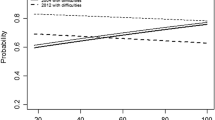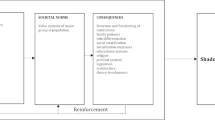Abstract
Most modern welfare states offer an extensive array of services and benefits that are wholly or partly financed by tax revenue. One missing link in explaining the long-run sustainability of such comprehensive welfare states could be the already-existing stock of trust. Indeed, our cross-country results suggest that trust determines the size of welfare states as well as three features that are arguably necessary for their preservation: high levels of political confidence, strong legal institutions protecting private property rights, and low levels of bureaucratic corruption.

Similar content being viewed by others
Notes
In relation to the particularly high trust levels of Scandinavian welfare states, it necessarily deserves mention that trust levels in Sweden and Denmark have increased since the early 1980s, just as trust levels on average fell in the United States from the late 1960s to the early 1990s. Yet, the particular levels of trust in Scandinavia cannot be attributed to the welfare state. In one of the first individual-level panel studies of trust, Dinesen and Sønderskov (2012) find that the trust increase for Denmark mainly is the result of a less trusting generation growing up around World War II that is now dying and being replaced by their more trusting children. Furthermore, the observed trust increase has occurred in a period in which both Denmark and Sweden rolled back central elements of the social democratic welfare state, which would, following Rothstein’s arguments, have led to a trust decline. Since we note the opposite, we suggest that the evidence is inconsistent with the welfare state causing the trust increase.
References
Aghion, P., Algan, Y., Cahuc, P., & Shleifer, A. (2010). Regulations and distrust. Quarterly Journal of Economics, 25, 1015–1049.
Alesina, A., & Guiliano, P. (2011). Family ties and political participation. Journal of the European Economic Association, 9, 817–839.
Algan, Y., & Cahuc, P. (2009). Civic virtue and labor market institutions. American Economic Journal: Macroeconomics, 1, 111–145.
Algan, Y., & Cahuc, P. (2010). Inherited trust and growth. American Economic Review, 100, 2060–2092.
Bergh, A. (2004). The universal welfare state: theory and the case of Sweden. Political Studies, 52, 745–766.
Bergh, A. (2009). Den Kapitalistiska Velfärdsstaten. Stockholm: Norstedts.
Bergh, A., & Bjørnskov, C. (2011). Historical trust levels predict the current size of the welfare state. Kyklos, 64, 1–19.
Bjørnskov, C. (2006). The multiple facets of social capital. European Journal of Political Economy, 22, 1–22.
Bjørnskov, C. (2007). Determinants of generalized trust. A cross-country comparison. Public Choice, 130, 1–21.
Bjørnskov, C. (2008). Social trust and fractionalization: a possible reinterpretation. European Sociological Review, 24, 271–283.
Bjørnskov, C. (2010). How does social trust lead to better governance? An attempt to separate electoral and bureaucratic mechanisms. Public Choice, 144, 323–346.
Bjørnskov, C., & Svendsen, G. T. (2007). Measuring social capital. Journal of Comparative Policy Analysis, 9, 275–292.
Butler, J., Guiliano, P., & Guiso, L. (2010). The right amount of trust (Working paper 450). Fondazione Eni Enrico Mattei.
CIA (2009). CIA world factbook 2009. Langley: Central Intelligence Agency.
Dearmon, J., & Grier, K. (2009). Trust and development. Journal of Economic Behavior & Organization, 71, 210–220.
D’Hernoncourt, J., & Méon, P.-G. (2011). The not so dark side of trust: does trust increase the size of the shadow economy? Journal of Economic Behavior & Organization, 81, 97–121.
Dinesen, P., & Sønderskov, K. M. (2012). Hvorfor stiger tilliden? Politica, 44, 87–110.
Dohmen, T., Falk, A., Huffman, D., & Sunde, U. (2008). The intergenerational transmission of risk and trust attitudes (IZA Working Paper 2380). Institute for the Study of Labour, Bonn.
Fischer, C. (2005). Bowling alone: what’s the score? Social Networks, 27, 155–167.
Freitag, M., & Traunmüller, R. (2008). Sozialkapitalwelten in Deutschland. Soziale Netzwerke, Vertrauen und Reziprozitätsnormen im subnationalen Vergleich. Zeitschrift für Vergleichende Politikwissenschaft, 2, 221–256.
GSS (2010). General Social Survey, 1972–2006 data file. Downloadable from http://www.norc.org/projects/General+Social+Survey.htm.
Guinnane, T. (2005). Trust: a concept too many. Jahrbuch für Wirtschaftsgeschichte, 1, 77–92.
Gwartney, J., & Lawson, R. (2009). Economic freedom of the world 2009. Downloadable from http://www.freetheworld.com/download.html.
Heineman, F., & Tanz, B. (2008). Trust and reforms. Journal of Economic Policy Reform, 11, 173–185.
Holcombe, R. C., & Rodet, C. S. (2012). Rule of law and the size of government. Journal of Institutional Economics, 8, 49–69.
Jensen, C., & Svendsen, G. T. (2011). Giving money to strangers: European welfare states and social trust. International Journal of Social Welfare, 20, 3–9.
Katz, H. A., & Rotter, J. B. (1969). Interpersonal trust scores of college students and their parents. Child Development, 40, 657–661.
Knack, S. (2001). Trust, associational life and economic performance. In J. F. Helliwell (Ed.), The contribution of human and social capital to sustained economic growth and well-being. Quebec: Human Resources Development Canada.
Knack, S. (2002). Social capital and the quality of government: evidence from the U.S. states. American Journal of Political Science, 46, 772–785.
Knack, S., & Keefer, P. (1997). Does social capital have an economic pay-off? A cross-country investigation. Quarterly Journal of Economics, 112, 1251–1288.
Lindbeck, A. (1995). Welfare state disincentives with endogenous habits and norms. The Scandinavian Journal of Economics, 97, 477–494.
Mueller, D. C. (2003). Public choice III. Cambridge: Cambridge University Press.
Naef, M., & Schupp, J. (2009). Measuring trust: experiments and surveys in contrast and combination (SOEP working paper 167). DIW Berlin.
Nannestad, P. (2008). What have we learned about generalized trust, if anything? Annual Review of Political Science, 11, 413–436.
Nunn, N. (2008). The long-term effects of Africa’s slave trades. Quarterly Journal of Economics, 123, 139–176.
OECD (2008). Growing unequal? Income distribution and poverty in OECD countries. Paris: Organization for Economic Cooperation and Development.
Ostrom, E., & Ahn, T. K. (2009). The meaning of social capital and its link to collective action. In G. T. Svendsen & G. L. Svendsen (Eds.), Handbook of social capital. The troika of sociology, political science and economics (pp. 17–35). Cheltenham: Edward Elgar.
Paldam, M. (2004). The Nordic welfare state—success under stress. European Journal of Political Economy, 20, 739–742.
Paldam, M., & Svendsen, G. T. (2001). Missing social capital and the transition in Eastern Europe. Journal of Institutional Innovation, Development and Transition, 5, 21–34.
Putnam, R. D. (1993). Making democracy work. Civic traditions in modern Italy. Princeton: Princeton University Press.
Rice, T. W., & Sumberg, A. (1997). Civic culture and democracy in the American states. Publius, 27, 99–114.
Robbins, B. (2012). Institutional quality and generalized trust: a nonrecursive causal model. Social Indicators Research. doi:10.1007/s11205-011-9838-1.
Rosenberg, M. (1956). Misanthropy and political ideology. American Sociological Review, 21, 690–695.
Rothstein, B. (2003). Social capital, economic growth and quality of government: the causal mechanism. New Political Economy, 8, 49–71.
Rothstein, B. (2009). The universal welfare state. In G. T. Svendsen & G. L. Svendsen (Eds.), Handbook of social capital. The troika of sociology, political science and economics (pp. 212–227). Cheltenham: Edward Elgar.
Rothstein, B., & Stolle, D. (2003). Introduction: social capital in Scandinavia. Scandinavian Political Studies, 26, 1–26.
Sabirianova Peter, K., Buttrick, S., & Duncan, D. (2010). Global reform of personal income taxation, 1981–2005: evidence from 189 countries. National Tax Journal, 63, 447–478.
Sapienza, P., Toldrà, A., & Zingales, L. (2010). Understanding trust (Working paper). Nortwestern University.
Standard and Poor’s (2012). Sovereign credit ratings. Retrieved from http://www.standardandpoors./ratings/govs-sovereigns/en/eu/ (February 2012).
Summers, A., Heston, R., & Aten, B. (2006). Penn world tables mark 6.2. CICUP, University of Pennsylvania.
Sønderskov, K. M. (2011). Does generalized social trust lead to associational membership? Unraveling a bowl of well-tossed spaghetti. European Sociological Review, 27, 419–434.
Tabellini, G. (2008). The scope of cooperation: values and incentives. Quarterly Journal of Economics, 123, 905–950.
Transparency International (2009). Transparency international corruption perceptions index 2009. Press release (October). Berlin: Transparency International.
Uslaner, E. M. (2002). The moral foundations of trust. Cambridge: Cambridge University Press.
Uslaner, E. M. (2008). Where you stand depends on where your grandparents sat: the inheritability of generalized trust. Public Opinion Quarterly, 72, 725–740.
WIID (2010). Word income inequality database v. 2.0c. Helsinki: UNI-Wider.
World Values Survey (2010). Data downloadable at http://www.worldvaluessurvey.org (date of access: 4-8-08).
Acknowledgements
We are grateful for comments from two anonymous referees and Bill Shughart that strongly improved the paper. All remaining errors are ours.
Author information
Authors and Affiliations
Corresponding author
Appendix
Appendix
Rights and permissions
About this article
Cite this article
Bjørnskov, C., Svendsen, G.T. Does social trust determine the size of the welfare state? Evidence using historical identification. Public Choice 157, 269–286 (2013). https://doi.org/10.1007/s11127-012-9944-x
Received:
Accepted:
Published:
Issue Date:
DOI: https://doi.org/10.1007/s11127-012-9944-x




